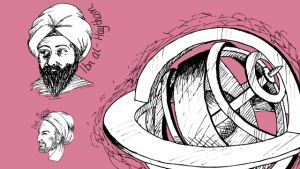 The 9th century philosopher, Al-Kindi captured the Islamic quest for knowledge perfectly when he said, “It is fitting for us not to be ashamed of acknowledging truth and to assimilate it from whatever source it comes to us. There is nothing of higher value than truth itself. It never cheapens or abases he who seeks. After the fall of the Roman Empire, Europe was thrown into the Dark Ages. Meanwhile, in the Islamic world, science and technology were thriving. This was the Islamic Golden Age, which extended from the 7th to the 13th century and paved the way for the Western enlightenment.
The 9th century philosopher, Al-Kindi captured the Islamic quest for knowledge perfectly when he said, “It is fitting for us not to be ashamed of acknowledging truth and to assimilate it from whatever source it comes to us. There is nothing of higher value than truth itself. It never cheapens or abases he who seeks. After the fall of the Roman Empire, Europe was thrown into the Dark Ages. Meanwhile, in the Islamic world, science and technology were thriving. This was the Islamic Golden Age, which extended from the 7th to the 13th century and paved the way for the Western enlightenment.
There are certain aspects of Islam that require precise astronomical knowledge. For instance, morning and evening prayers take place at dawn and dusk; precisely defined as the times when the Sun is 18° below the horizon. As a result, Islamic astronomers brought an accuracy and precision to the field that is impressive even by today’s standards. Al-Battani was one such scholar, calculating the length of the solar year to obtain a time within two minutes of modern values.
Using the astrolabe to calculate latitude and triangulate position, and an armillary sphere to model the orbits of celestial bodies, Islamic astronomers were able to make observations that refuted the earlier Greek theories on planetary motion. Although they did not make the leap to a model of the solar system with the Sun as the central body, Islamic scholars disproved many Ptolemaic ideas such as the idea that planetary motion was perfectly circular.
Algebra and algorithm are both Arabic words that are derived from al-Khwarismi’s work (algorithm stemming from the Latinisation of his name). A 9th century Islamic scholar, he devised algebra by fusing the Greek and Indian numerical systems and presented his ideas in ‘Kitab al-Jabrwa-l-Muqabala‘ (al-Jabrwa being the origin of the word algebra). At the time, Greek mathematics dealt mainly with geometry (shapes and their properties such as volume and area), whilst in India the ten-symbol decimal system had developed, making calculations much simpler. Al-Khwarismi’s algebra introduced the concept of treating numbers as objects. By disregarding the actual numerical value of these objects and replacing them with symbols, general equations could be used to perform a function on any numerical system.
Ibn al-Haytham, born in 965 AD, was motivated by the Islamic notion of shukuk (doubt)—the underlying driving force behind the scientific method. In his ‘Book of Optics’ he was able to combine the two predominating theories on the workings of the eye. Euclid and Ptolemy believed that the eye emitted rays of light to illuminate objects allowing us to see; whilst Aristotle was a proponent of the idea that objects had a physical form that entered the eye. Using a pin-hole camera, Ibn al-Haytham was able to show that images are formed from the light reflected by objects. Importantly, he noticed that this picture was inverted, thus indicating that light travels in straight lines, and the observation that it changed according to changes in the outside world confirmed that the image was indeed a projection of the outside world. By making parallels between this camera and the human eye, he correctly theorised that the pupil was acting as the aperture, with the image projected onto the back of the eye for processing by the brain.
Ibn Sina was an 11th century polymath who wrote ground-breaking treatises on medicine such as ‘The Book of Healing’ and ‘The Canon of Medicine’. The latter was used in European universities well into the 17th century. Its revolutionary ideas included the use of clinical, randomised trials for drug testing and evidence-based medicine. He brought together the world’s knowledge on healthcare and contributed significantly to the creation of medicine as a subject of study. One may wonder why the Islamic world today is not at the forefront of science and why many modern scientific theories are not as widely accepted there. From the mid-13th century the Islamic Empire began to decline and ensuing wars resulted in the destruction of important texts.
Moreover, with the discovery of the New World in 1492, the flow of money and gold went west through Spain and Italy. Subsequently, science thrived in those parts of the world. The development of modern science in the West was organic and the incremental changes in ideas were slowly assimilated and accepted. In contrast the lack of peace and prosperity in the Islamic parts of the world meant that scientific progress was arrested. Today there is some reluctance to accept certain ideas that are seen as “Western philosophy” rather than true science.
In recent years, Muslim scientists have once again begun making significant contributions to modern science; a notable example being the physics Nobel Laureate Mohammad Abdus Salam with his work on unifying the weak and electromagnetic forces. With such a rich history, it can only be hoped that the scientific legacy of Islam continues to grow.
Abubakar Abioye is a 3rd year medical student at Balliol College.
Art by Emma Wilkins.
![A Lost Legacy The 9th century philosopher, Al-Kindi captured the Islamic quest for knowledge perfectly when he said, “It is fitting for us not to be ashamed of […]](/wp-content/uploads/2011/10/A-lost-legacy_preview-620x300.png)